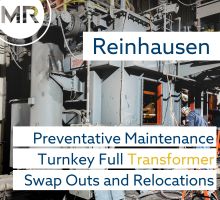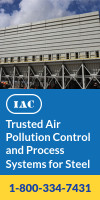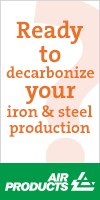ThyssenKrupp Steel to Restart Blast Furnace 1 at Duisburg-Schwelgern
03/20/2008 - ThyssenKrupp Steel’s Schwelgern 1 blast furnace in Duisburg is expected to begin its fifth campaign at the beginning of April, following completion of a record downtime of only 70 days.
|
ThyssenKrupp Steel’s Schwelgern 1 blast furnace in Duisburg is expected to begin its fifth campaign at the beginning of April, following completion of a record downtime of only 70 days.
After three and a half decades of production, blast furnace Schwelgern 1 will produce its one-hundred-millionth tonne of pig iron at the beginning of May 2008—a benchmark which only few blast furnaces worldwide have achieved.
Schwelgern 1’s fifth campaign will be the longest so far: the project team expects it to last more than 12 years at a continued production rate of 10,000 tonnes of pig iron a day.
|
The blast furnace has been undergoing a thorough modernization, including a complete reline. The furnace cooling system also is being upgraded, including the replacement of 1800 of the 2100 total cooling plates. To intensify cooling in the bosh, six rows of cooling plates will replace one row of staves.
In the casthouses, the complete runner system and refractory lining are being replaced, and the taphole equipment is also being overhauled. The refectory lining of the hot blast stoves is being refurbished, and the stockhouse screens, controls, and extraction lines are being modernized. Additional repairs and renewals are being carried out on the coal injection system, gas cleaning system, emergency water supply, re-cooling system, and slag granulation system, as well as the expansion turbine, clarification plant, and sludge drying system.
An approximately 300-strong team from ThyssenKrupp Steel is handling the modernization project with the help of around 100 national and international contractors. The company said that a significant proportion of the work is being carried out by companies from other segments of the ThyssenKrupp Group.
To keep downtime to a minimum, the modernization project was planned down to the last detail over a one-and-a-half year period, with the project team drawing on experience from previous relines, before the furnace was shut down. The team is optimistic that it will complete the work within 70 days, which compares to a turnaround of over 80 days for the last reline, in 1996.
Overall, the upgrade represents an investment of around 150 million euros, with over a tenth of the cost dedicated to the installation of additional pollution control equipment. The company had previously installed a new filter unit (2004) to collect casthouse and stockhouse dust; this installation was part of an extensive dust-reduction program which ThyssenKrupp Stahl agreed to in April 2001 with the North Rhine Westphalia environment ministry. As part of the 2008 reline, that stockhouse dust extraction system is being renewed, the hoods on the slag granulation unit are being replaced, and the silencers on the energy-recovery expansion turbine are being overhauled. Noise barriers in the clarification plant and sludge drying system also are being renewed to minimize noise emissions. Incidentally, when the furnace was built at the beginning of the 1970s, the casthouse and stockhouse dust collection systems, gas cleaning, water treatment and noise protection facilities were regarded as the latest in international blast furnace technology.
Since blast furnace Schwelgern 1 began operation on February 13, 1973, new technical solutions have been found and implemented which are today international standard. The then August-Thyssen-Hütte (ATH) in Duisburg celebrated the new blast furnace as the largest in the Western world. It was a project of gigantic dimensions: on 17.5 hectares of land, 210,000 cubic meters of earth were excavated for the 110 meter tall furnace, which had a hearth diameter of 14 meters and a furnace capacity of 4,200 cubic meters.
After three and a half decades of production, blast furnace Schwelgern 1 will produce its one hundred millionth ton of pig iron at the beginning of May 2008—a benchmark which only few blast furnaces worldwide have achieved. Each day, the furnace, which was built for 175 million euros, processes about 20 freight trains each containing 20 cars of ore, sinter, coke and coal. It produces 10,000 tonnes of pig iron a day, twice as much as the previous best blast furnace. Every second, two blowers press around 100 cubic meters of blast air through 40 tuyeres into the furnace. Almost 100 water pumps are installed for cooling, gas cleaning, and converting blast-furnace slag into granulate. The water is treated and completely recycled.



.jpg?lang=en-US&ext=.jpg)
.gif?width=220&height=200&mediaprotectionhash=374c6b9a31f2b2fbfc7937391034efb46fd57feba997b9ad2ae9a0bd3d48329d&ext=.gif)

.gif?width=100&height=200&mediaprotectionhash=e2d5b15d68f84f22038524be6c58e5268d67b7f44494b544e29a8d53c5b959ba&ext=.gif)


